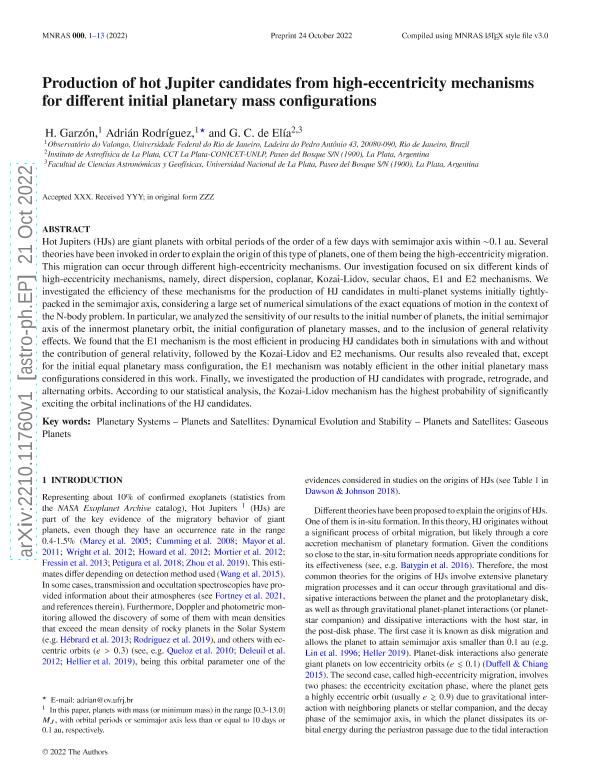Mostrar el registro sencillo del ítem
dc.contributor.author
Garzón, H.
dc.contributor.author
Rodríguez, Adrián
dc.contributor.author
de Elia, Gonzalo Carlos

dc.date.available
2023-09-08T13:17:17Z
dc.date.issued
2022-12
dc.identifier.citation
Garzón, H.; Rodríguez, Adrián; de Elia, Gonzalo Carlos; Production of hot Jupiter candidates from high-eccentricity mechanisms for different initial planetary mass configurations; Wiley Blackwell Publishing, Inc; Monthly Notices of the Royal Astronomical Society; 517; 4; 12-2022; 4986-5002
dc.identifier.issn
0035-8711
dc.identifier.uri
http://hdl.handle.net/11336/210907
dc.description.abstract
Hot Jupiters (HJs) are giant planets with orbital periods of the order of a few days with semimajor axis within ∼0.1 au. Several theories have been invoked in order to explain the origin of this type of planets, one of them being the high-eccentricity migration. This migration can occur through different high-eccentricity mechanisms. Our investigation focused on six different kinds of high-eccentricity mechanisms, namely, direct dispersion, coplanar, Kozai-Lidov, secular chaos, E1 and E2 mechanisms. We investigated the efficiency of these mechanisms for the production of HJ candidates in multiplanet systems initially tightly-packed in the semimajor axis, considering a large set of numerical simulations of the exact equations of motion in the context of the N-body problem. In particular, we analyzed the sensitivity of our results to the initial number of planets, the initial semimajor axis of the innermost planetary orbit, the initial configuration of planetary masses, and to the inclusion of general relativity (GR) effects. We found that the E1 mechanism is the most efficient in producing HJ candidates both in simulations with and without the contribution of GR, followed by the Kozai-Lidov and E2 mechanisms. Our results also revealed that, except for the initial equal planetary mass configuration, the E1 mechanism was notably efficient in the other initial planetary mass configurations considered in this work. Finally, we investigated the production of HJ candidates with prograde, retrograde, and alternating orbits. According to our statistical analysis, the Kozai-Lidov mechanism has the highest probability of significantly exciting the orbital inclinations of the HJ candidates.
dc.format
application/pdf
dc.language.iso
eng
dc.publisher
Wiley Blackwell Publishing, Inc

dc.rights
info:eu-repo/semantics/openAccess
dc.rights.uri
https://creativecommons.org/licenses/by-nc-sa/2.5/ar/
dc.subject
PLANETARY SYSTEMS
dc.subject
PLANETS AND SATELLITES: DYNAMICAL EVOLUTION AND STABILITY
dc.subject
PLANETS AND SATELLITES: GASEOUS PLANETS
dc.subject.classification
Astronomía

dc.subject.classification
Ciencias Físicas

dc.subject.classification
CIENCIAS NATURALES Y EXACTAS

dc.title
Production of hot Jupiter candidates from high-eccentricity mechanisms for different initial planetary mass configurations
dc.type
info:eu-repo/semantics/article
dc.type
info:ar-repo/semantics/artículo
dc.type
info:eu-repo/semantics/publishedVersion
dc.date.updated
2023-09-05T18:03:46Z
dc.journal.volume
517
dc.journal.number
4
dc.journal.pagination
4986-5002
dc.journal.pais
Reino Unido

dc.journal.ciudad
Londres
dc.description.fil
Fil: Garzón, H.. Universidade Federal do Rio de Janeiro; Brasil
dc.description.fil
Fil: Rodríguez, Adrián. Universidade Federal do Rio de Janeiro; Brasil
dc.description.fil
Fil: de Elia, Gonzalo Carlos. Consejo Nacional de Investigaciones Científicas y Técnicas. Centro Científico Tecnológico Conicet - La Plata. Instituto de Astrofísica La Plata. Universidad Nacional de La Plata. Facultad de Ciencias Astronómicas y Geofísicas. Instituto de Astrofísica La Plata; Argentina
dc.journal.title
Monthly Notices of the Royal Astronomical Society

dc.relation.alternativeid
info:eu-repo/semantics/altIdentifier/url/https://academic.oup.com/mnras/article-abstract/517/4/4986/6767616?redirectedFrom=fulltext
dc.relation.alternativeid
info:eu-repo/semantics/altIdentifier/doi/http://dx.doi.org/10.1093/mnras/stac3004
Archivos asociados
